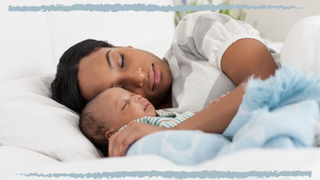Baby sleep training - what is it, when to start and the best teaching methods
Want to try a sleep method on your baby? We explain what's involved


Baby sleep training, also known as sleep teaching, is a hot topic discussed at length among many tired parents and carers.
There’s so much advice and guidance out there that it’s hard to cut through the noise - whether it's conflicting opinions around best baby monitors or the risks and benefits of co-sleeping. But only you know what’s best for yourself, your baby, and your family when it comes to teaching your new baby how to sleep. And if your child is going through one of the sleep regression ages then sleep training may help you through it. Failing that, in the first few weeks of a newborn life a lot of parents choose from the best swaddles and then learn how to swaddle their baby.
We've asked both sleep-deprived parents and the experts everything there is to know about ‘baby sleep training’, so that you can have the information to hand to make your own decision for you and your baby.
Baby sleep training - what is it?
Baby sleep training, also known as baby sleep teaching, is a way to enable and support your baby to learn the skills they need to fall asleep. If sleep teaching is something you want to try, studies say that 6 months is the best age to start. Take a look through one of our expert-approved baby sleep books for more info too.
And certified baby sleep consultant Sarah Patel, who is the founder of Teach to Sleep, a former teacher and mom of two, agrees. She tells us; "It's less about 'training', they're not dogs. It's about teaching your baby. You are taking the first of many steps to teach your baby how to do something new."
Teaching your baby how to wind down for the night, to self-regulate and soothe helps them to relax, according to science. Which will hopefully send them into a sleepy slumber, meaning you can too. And, while a newborn sleep schedule sounds ridiculous it's a good habit to get into, the main thing to remember is that sleep is so important for parents during these first years of a baby's life. Research shows that lack of sleep can lead to depression and low moments; both of which can greatly affect your mental health and quality of life.
It's important to know that babies - like adults - are not meant to sleep through the night. Read that again; Babies are not meant to sleep through the night. Experts and their reports say so too.
GoodtoKnow Newsletter
Parenting advice, hot topics, best buys and family finance tips delivered straight to your inbox.

Mom-of-one and Goodto.com Family Editor, Stephanie Lowe was surprised by this as a first-time mom. “Before Ted was even a year old I was asked ‘is he sleeping through yet?’ so many times, and by Health Visitors too. So I always just assumed that was what he was supposed to be doing.”
When in reality, that bar is unrealistic. Babies wake for many different reasons and the process of baby sleep training and teaching will help your little one learn to fall back to sleep after they’ve woken in the night.
Baby sleep training and teaching isn’t for everyone. If you’re co-sleeping with your baby and it’s working for you then that’s great. It’s also okay to take a step back if, for any reason, co-sleeping no longer works for you and you need to find a new way.
Learning how to sleep is not a one off event. It’s an ongoing ever-evolving process which will ebb and flow as your baby and their circadian rhythm - so important according to research - grows. Learning to be flexible around this will help to enable solid hours of sleep.
Before trying any baby sleep training
A new baby can be a bit overwhelming- it can feel like everything is a guessing game - it’s always worth remembering that they are little humans. And, just like humans, they may be waking up - like adults - because they’re too hot or too cold, still hungry or just need the toilet. So, before you try any baby sleep-training and teaching make a note of the below - these points may help set you and your baby up for sleep success.
- Your baby is at least 6 months of age
- Make sure baby isn’t teething, ill or unwell in any way
- Double check that baby is eating enough during the day. Hunger pangs can prevent them from settling or they may wake up with hunger during the night.
- Is a consistent bedtime routine in place? This could be as simple as playing the same lullaby as you get them ready for bed, just a signal each night so they know bedtime and sleep is next
Sleep training a newborn
You might hear a lot of 'no you shouldn't' around sleep training a newborn. But, all newborns are different, and all family circumstances are different too. You are free to make the decision that is right for you and your baby. Baby sleep training isn't just about cry it out. There are many methods to try such as Pick up Put Down, E.A.S.Y and the Responsive Plan, all detailed below.
With a newborn it's worth noting that if you're sleep training to reduce crying, this isn't always the outcome. Studies show that parents of newborns (i.e. the first 3 months) are more concerned with crying than sleep. Sleep interventions in the first 3 months may improve sleep but have no effect on crying. The crying, feeding and sleep problems co-evolve, particularly in the first neurodevelopmentally sensitive 4 months.
Research shows that a newborn infant starts to develop a rhythm of cortisol at 8 weeks of age, with melatonin and sleep efficiency developing at 9 weeks. But, babies don't fully develop their internal circadian rhythm until around 4-6 months. Which is why many studies suggest waiting until 6 months before trying to baby sleep train.
So, if you do want to try and sleep train your baby it maybe worth understanding that they may not be biologically developed enough to sleep as long as you want or need them too. Sleep expert and founder of Little Sleep Stars Lauren Peacock believes 'it's never too early'. "I would suggest starting a bedtime routine as young as 2-3 weeks of age."
Sleep training a 4-month old
While experts say 6 months is the best time, for a family that needs big chunks of sleep right now, sleep coaching at 4-months may be a good option.
Some parents may feel pressured by sleep advice books who say to start sleep training now (some say even earlier) or experts who warn that if you don’t do it now, it will be much harder — maybe even impossible — later.
Sleep is difficult at 4 months old due to brain growth and development. The biggest culprit could be the 4 month sleep regression — a massive jump in both physical growth and brain development that can result in feeding disruptions or bursts, and more disrupted sleep. For many babies, sleep isn’t always something that stays fixed. It can be full of ups and downs as little ones mature across those first two years.
But, at 4 months is the time your baby's circadian rhythm starts to kick in and you may start to notice that your baby is sleeping for longer and my be waking less for fewer night feeds. Around 4 months is when you may also see your baby's sleep patterns emerge. Remember, all baby's are different. Even siblings, just because your first would only co-sleep, doesn't mean your second will be the same.
While many experts advise waiting until 6 months to sleep train, if you need or want to now, that is your call. Below are more details on the more popular baby sleep training methods.
Sleep training a 6-month old
Many expert studies claim that 6 months old is the perfect time to start sleep training. Sleep training begins at bedtime as this is when your little one is most likely to be snoozy. Trying to sleep train both naps and nighttime together will just lead to a cranky baby.
A bedtime routine might be a good place to start. If you don't have one, don't worry it's never too late to set one up. The main purpose of this routine is to calm your baby in the evening. And this can look different from baby to baby.
Goodto.com Family Editor and mom-of-one Stephanie Lowe says: "We chose not to do a bath at bed time to soothe Ted, as so many experts said to. It only seemed to wake him up. He would go to town on squealing and splashing and would be buzzing before bed. So we took the lead from him and instead went for gentle lullabies on my Spotify while changing him in a dim room. Followed by a book then bottle."
Once you have a nighttime routine in place, you may like to look at reducing waking at night. By 6 months, if not teething or unwell, your baby is capable of sleeping for 4-8 hour stints. A baby sleep training method, see below, can help with this.
Sleep training a 1-year old
If your toddler calls out at night for hugs or is in your bed by daybreak and you're happy with this, then you do what works for you.
If, however, this sleep behavior is taking its toll and you and your toddler are exhausted it may be time to look into sleep training. It's never too late, sleep training is not a finite 6-months-old-or-not-at-all deal. Sleep regression ages go from 4 weeks to 18 months, and sleep training may help you through it.
Sleep training with a toddler is different as they are more developed and can communicate easier and also, push boundaries. With that in mind, Lauren Peacock, sleep expert and founder of Little Stars Sleep says: "consistency, setting boundaries and being clear with your toddler is what will help."
Goodto.com's Family Editor and mom-of-one Stephanie Lowe says: "I also found giving my toddler some of the "power" to make decisions himself around bedtime really help. Choice of language helps here. Saying things like 'It's time for bed, do you want to walk upstairs or do you want a carry?'. That way he felt he was in control of it, when ultimately the outcome was what I, the parent wanted. How he got there was how he, the toddler wanted."
Be ready for some pushback at this age, as parents, it's our job as parents to set boundaries and as a toddler, it's their job to push them. It's part of development.
Ultimately, how you deal with your toddler fighting back at bedtime is up to you, and every family has a different comfort level. You could let him cry it out, you could periodically check in on him or you could stay in his bedroom—sitting somewhere away from the crib—until he falls asleep. It's your choice.
Below we detail some of the most popular baby sleep-training methods which may work for your 1-year old.
Baby sleep training methods
1. The Ferber Method
The Ferber method of sleep training is periodically checking in on your crying baby at timed intervals increasing steadily, soothing the baby verbally with no feeding and no picking up, according to studies.It claims to help babies learn to self-sooth; to ultimately fall asleep on their own. And to fall back to sleep with minimal interaction when they wake in the night.
Sarah says; ‘When it comes to any form of cry it out methods, remember that it’s not something you have to do. There is a growing number of gentle sleep consultants like myself who use responsive methods and get the same results."
She adds; "I don’t judge any parent for baby sleep training. I did it with my daughter in pure desperation, parenting is hard enough without judgment. My advice, do what feels right to you, research shows that a parent’s instinct is usually the most accurate.”
As sleep training methods go, the Ferber method is divisive among baby sleep experts.
How does the Ferber method work?
Similar to the Ferber method, the NHS also recommends that you establish a baby bedtime routine, such as dimmed lights and reading a story. Add some helpful Baby sleep aids to a good routine and you might be on your way to getting some shut-eye. (You could even try turning your iPhone into a white noise machine to soothe your baby to sleep.)
Here’s what the Ferber method looks like in six steps;
- Ensure your bedtime routine ends with a consistent phrase or song i.e. ‘It’s time for sleep’ or ‘I love you and will see you in the morning’
- Lay your baby or toddler down drowsy but awake
- Leave the room (or sit in a chair if you prefer to try to stay in the room)
- If your child starts to cry, start your timer. If your child is not crying, no need to start the timer
- Once the timer goes off, go check-in and offer comfort. Be sure to stop soothing and/or leave while your child is still awake
- Repeat the check-in and comfort process with the different intervals (shown below) until your they fall asleep
2. Controlled crying
Another well-known divisive method involves strategically leaving your baby to cry for progressively longer periods of time. So they eventually learn to sleep without needing you for comfort.
Sophia Nomicos, founder of Mas and Pas, says that the method is reported to work for many parents. She tells us, “This doesn’t only benefit baby at bedtime, but when they come out of sleep cycles during the night, they are often able to settle themselves to sleep again without waking their parents. It also seems to be one of the quickest ways to sleep train a child with a number of parents reporting their children were sleeping through the night after just 3-5 nights of starting the method.”
Reports show that understanding a baby’s sleep cycle is important for parents. Because babies are not born with a strong circadian rhythm, which is why sleep teaching is only recommended for 6 months and older. Parents who want to sleep train have to work with their baby’s unique development timeline.
How does the controlled crying method work?
Sophia tells us, “The controlled crying method involves parents or caregivers putting their child to sleep in their crib at bedtime and leaving the room. When the child cries it’s for a short period of time, usually between 2 and 10 minutes, before the parent goes in and comforts them.
“When [parents do go in and comfort them] it’s important that they do not make eye contact or lift the baby out of the crib. They can stroke or soothe them while they’re in their bed until they are calm.”“The parent then leaves the room again and if the baby cries they repeat the process until the baby falls asleep.”
“Most parents report the first night to be the hardest.” Sophia says, “The key is consistency and doing the same technique in the same way, every night for five nights.”
3. The responsive plan
Fairly new to main stream parenting, and sits under the Gentle Parenting remit with consistency at the center. Research shows consistency is key in empowering and enabling your baby to sleep. While not a ‘one-method-fits-all’ approach - it’s different and tailored for every parent and baby, this plan teaches parents to get out of their own way; to support their baby as they teach them to sleep.
It’s about parents not being afraid of their child crying or of any resistance or protesting they might give. As it is always lovingly attended to, they're not 'left to cry'. They are simply being given the opportunity to practice what they are capable of.
We as parents might like to think about giving our baby what they need to learn to sleep, over what they want. Eve, one half of Calm & Bright Sleep Support tells us; "One of the reasons people don't sleep train is they want to be 'need meeting' parents. But it's hard to be a need-meeting parent without sleep. There's a reason we spend a third of our lives in that state, because sleep really matters. And it's not just us that feels rubbish on no sleep, so do babies."
‘Solid sleep with love’ is the motto of Calm & Bright Sleep Support. A family run business with two sisters at the helm and backed by an NHS superteam of paediatric nurses and psychologists. They encourage lovingly responding through actions, to show your baby that you will always come back.
How does the responsive plan work?
Similar to baby-led weaning, you follow your baby's pattern. In a responsive and attachment conscious approach. If there's a chance that what might be standing between your baby and solid sleep is you and your responses to your baby it might be time to move on and try something else.
4. The E.A.S.Y method
It stands for eat, activity, sleep, you-time. This method was developed by Tracy Hogg, author of the book Secrets of the Baby Whisperer. It’s positioned as a ‘structured routine’ not a schedule. E.A.S.Y is about keeping up the same daily pattern and repeating it every day.If you’re too busy watching the clock and not your baby you’ll miss important signals (like the first signs of tiredness).
Our sleep expert Lauren Peacock says, “The E.A.S.Y routine creates a consistent flow to the day and provides opportunities for babies to experience falling asleep in different ways, rather than only on the breast or bottle.
“Parents often find their baby feeds well immediately on waking. I recommend feeding babies on demand, which will sometimes take a family outside of the E.A.S.Y routine – and that’s okay too!”
How does the E.A.S.Y method work?
The EASY method is essentially a three hour routine that starts with babies being fed until they are full (Eat), play (Activity) and then a nap (Sleep). The you-time begins when your little one is having a sleep.
For example:
E - 7am wake up and feed A - 7.30am activity S - 8.30am 90 min nap Y - Your time
E - 10am Wake and feed A - 10.30am activity S - 11.30am 90min nap Y - You time
E - 1pm feed A - 1.30pm activity S - 2.30pm 90min nap Y - You time
E - 4pm feed S - 5pm bed
To be sure that this routine works, baby will need to eat before bedtime and around the time of 5pm to 7pm and then again between 6pm to 8pm, which should fill them up for the night.
A feed at about 10pm, known as the dream feed, is the last one of the night.
Although this routine is structured it encourages you to be baby-led too, if your baby is showing tired signs but they’re not due a nap for another 30 minutes, follow their lead and put them down.
5. The Pick up Put Down method
As a baby sleep-training tool, this is ideal for use from 4 months old to a year. It’s also a problem-solving method. With this method your child is neither dependent on you to go to sleep nor do they feel abandoned. It's magic, it's hard consistent work. As with all new approaches you need to give your baby time to adapt.
How does the Pick Put Down method work?
The pick up put down, or PU/PD, method involves you going through your baby's normal bedtime routine, then putting her down to bed drowsy but awake. When and if she cries, pick her up and soothe her. Put her back down in the crib as soon as she stops crying.
Repeat the process until your baby falls asleep. Just be aware that this sleep training method can take a long time. And requires a good deal of patience. Get the support where you can, even if it’s just your partner/mom/friend sitting outside counting how many times you’ve gone in.
Related features:
- 8-month sleep regression causes, signs - and how I survived it with my son
- How to get a baby to sleep - Your ultimate guide
- Three clever expert tricks to help your baby's sleep routine when the clocks go back
- 5 easy switches to help kids stay fast asleep until the morning
Video of the Week

Stephanie Lowe is Family Editor at GoodToKnow covering all things parenting, pregnancy and more. She has over 13 years' experience as a digital journalist with a wealth of knowledge and experience when it comes to all things family and lifestyle. Stephanie lives in Kent with her husband and son, Ted. Just keeping on top of school emails/fund raisers/non-uniform days/packed lunches is her second full time job.
-
 Why do babies need to lie flat in a pram?
Why do babies need to lie flat in a pram?Wondering why babies need to lie flat? Experts reveal all — plus whether or not a baby should sleep in a pram
By Charlotte Duck Published
-
 The 3 stages of play every parent needs to know to save their sanity (and you're probably nailing #2)
The 3 stages of play every parent needs to know to save their sanity (and you're probably nailing #2)By Dr Amanda Gummer Published

